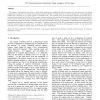174 search results - page 14 / 35 » How efficient is estimation with missing data |
RCIS
2010
13 years 6 months ago
2010
—The strategies for mining frequent itemsets, which is the essential part of discovering association rules, have been widely studied over the last decade. In real-world datasets,...
CORR
2010
Springer
13 years 8 months ago
2010
Springer
Predicting the occurrence of links is a fundamental problem in networks. In the link prediction problem we are given a snapshot of a network and would like to infer which interact...
WCE
2007
13 years 9 months ago
2007
— Imputation of missing data is important in many areas, such as reducing non-response bias in surveys and maintaining medical documentation. Estimating the uncertainty inherent ...
ICML
1994
IEEE
13 years 11 months ago
1994
IEEE
Model selection is important in many areas of supervised learning. Given a dataset and a set of models for predicting with that dataset, we must choose the model which is expected...
NN
1998
Springer
13 years 7 months ago
1998
Springer
The number of required hidden units is statistically estimated for feedforward neural networks that are constructed by adding hidden units one by one. The output error decreases w...

